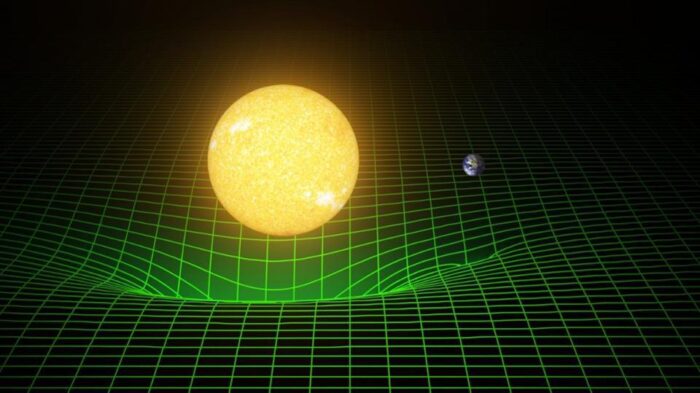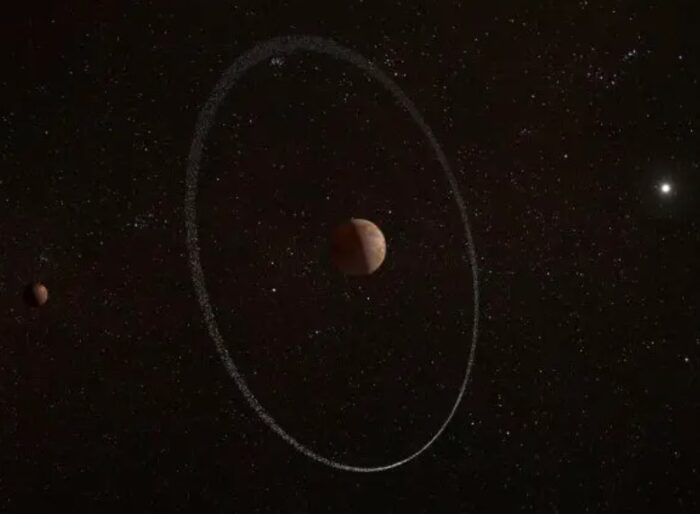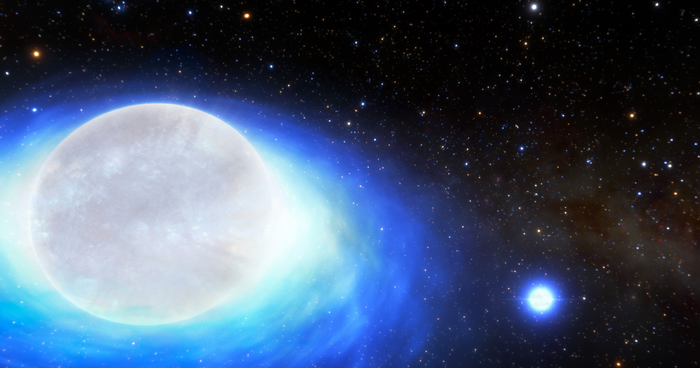Feb
10
2023
 I recently received an e-mail question from an SGU listener about the speed of gravity. They were questioning a statement they heard by Neil DeGrasse Tyson that if the sun were magically plucked from existence, the Earth would not feel the effects for 8 minutes and 20 seconds – the time it takes for light to travel from the sun to the Earth. This blew their mind, writing: “That statement doesn’t make sense to me. What DeGrasse is saying is that we don’t actually orbit the sun but a point in space where the sun was 8 minutes 20s ago.”
I recently received an e-mail question from an SGU listener about the speed of gravity. They were questioning a statement they heard by Neil DeGrasse Tyson that if the sun were magically plucked from existence, the Earth would not feel the effects for 8 minutes and 20 seconds – the time it takes for light to travel from the sun to the Earth. This blew their mind, writing: “That statement doesn’t make sense to me. What DeGrasse is saying is that we don’t actually orbit the sun but a point in space where the sun was 8 minutes 20s ago.”
Actually, that’s exactly right. He did get it. We see the sun as it was 8 minutes 20 seconds ago. We also feel the sun as it was at that time – in every way. The speed of light is more than the maximal relative velocity that energy travels through the universe, it is the speed at which reality propagates throughout the universe. No effect can exceed the speed of light – not information, matter, energy, or force.
We can use the General Relativity conception of gravity, that matter curves space time and that matter and energy travel in a straight line through curved space. You have likely seen the typical graphical representation of this, with a heavy object like a planet or star distorting a grid of spacetime like a heavy ball resting on a stretched piece of fabric. This is actually just a conceptual aid, not an accurate depiction. It is missing one dimension – space is represented as a two-dimensional fabric stretching into a third dimension. You need to add a dimension to represent reality, which is three dimensions. Some experts say that three dimensional space is being curved in a fourth dimension, but others say you can work the math to describe the curvature of 3D space without invoking a 4th spacial dimension. I’m not sure what the current consensus is – I’ll have to look deeper when I have time (if anyone has a good reference, please share it in the comments).
Continue Reading »
Feb
09
2023
 Scientists love mysteries, because that is where new discoveries lay. It is nice to find evidence consistent with existing theories, providing further confirmation, but it’s exciting to find evidence that cannot be explained with existing theories. Astronomers may have found such a mystery in the dwarf planet Quaoar – it has a ring where one shouldn’t be.
Scientists love mysteries, because that is where new discoveries lay. It is nice to find evidence consistent with existing theories, providing further confirmation, but it’s exciting to find evidence that cannot be explained with existing theories. Astronomers may have found such a mystery in the dwarf planet Quaoar – it has a ring where one shouldn’t be.
When we think of planetary rings we of course think first of Saturn, which has by far the largest and most impressive ring system in the solar system. But all the gas giants have their own rings, including Jupiter, Uranus, and Neptune. None of the smaller rocky planets have detectable rings. This is likely not a coincidence and relates to how rings form and how long they will last. But smaller bodies can have rings. Saturn’s moon Rhea may have a faint ring of its own. There is even an asteroid, Chariklo, which has two faint rings.
Rings are basically linear clouds of dust, ice, and other material that spreads out in an orbit around a planetary body. They form in one of two ways. For large planets like Saturn, if a moon’s orbit decays to the point where it gets within the Roche limit (the point at which tidal forces are so great they tear apart any large object), then the moon will break apart into debris that forms a ring. But anything that spreads dust around a planet can also feed a ring. For example, when meteorites hit the moons of Jupiter they throw up dust which can feed its faint ring system. Because the material that forms rings are close to their host planet they also tend to slowly rain down to the surface, so they have a limited lifetime. Saturn will eventually lose its beautiful rings. But new rings may also form. When Phobos gets too close to Mars one day it will break up and become a Martian ring system.
Continue Reading »
Feb
07
2023
 Communicating about emerging technology can be challenging because it is often difficult to find the real obstacles to the widespread adoption of that technology. Most reporting focuses on the hype. Technical articles are the most helpful, but they are usually not geared to a non-expert audience. This means that they don’t always give a big-picture view from a practical perspective. Rather, they are focusing on the technical details relevant to the specific study. Usually I learn about a major hurdle from an article which purports to solve it – although even then they may be focused on the problems they can potentially solve while not explicitly discussing remaining hurdles. It takes time and digging to piece together a full picture. Sometimes I have the opportunity to speak with the right kind of expert, or they themselves engage in helpful science communication and spell it out.
Communicating about emerging technology can be challenging because it is often difficult to find the real obstacles to the widespread adoption of that technology. Most reporting focuses on the hype. Technical articles are the most helpful, but they are usually not geared to a non-expert audience. This means that they don’t always give a big-picture view from a practical perspective. Rather, they are focusing on the technical details relevant to the specific study. Usually I learn about a major hurdle from an article which purports to solve it – although even then they may be focused on the problems they can potentially solve while not explicitly discussing remaining hurdles. It takes time and digging to piece together a full picture. Sometimes I have the opportunity to speak with the right kind of expert, or they themselves engage in helpful science communication and spell it out.
One of the many examples of this is 2D material – material that is one atom or molecule thick. The most famous such material is graphene, a single atom thick sheet of carbon arranged in a “chicken wire” pattern. It’s easy to find articles discussing all the amazing physical properties of graphene and other 2D materials and all the potential future applications. This may leave one curious as to why we have not been seeing more applications using this material. The short answer is that we do not yet know how to mass produce graphene in bulk and without defects. We can crank out lots of small pieces (or short pieces of carbon nanotubes, which are essentially rolled-up graphene), but they are both short and riddles with defects. This doesn’t matter if we are just adding it to as filler to another material to make it stronger, but won’t work for most of the exciting applications. Small defects also matter because one such defect can be a vulnerable point from which the entire sheet or nanotube and unzip.
Another application with amazing potential but with serious hurdles in the way is 2D computer chips. Silicon-based chips have proven to be a powerful technology, that has kept Moore’s law (the general observation that the density of transistors on a chip has roughly doubled every 18 months or so) going for decades. But silicon-based chips are running into some fundamental limits with the laws of physics. You can only make transistors so small before they cannot function. Transistors are now down to the 2 nm size, and this is close to the limit where classical physics transitions to quantum physics (to be clear, we are not talking about quantum computers, which is an entirely different technology). The limitation is the ability to control the flow of electrons through transistors. If the flow becomes chaotic or uncontrollable, then the chip doesn’t work. (This is an admittedly simplified non-technical description of the issue.)
Continue Reading »
Feb
03
2023
 Researchers report a 3D scan of the oldest vertebrate fossil brain yet discovered – in the head of a 319 million year old ray-finned fish. The specimen was actually found a hundred years ago in a coal mine in England, and has been sitting in a museum draw after it was initially described. It is a skull bone only, and the only specimen of this species (Coccocephalus wildi). New technology now allows us to scan the fossil, peering inside to see the fossilized soft tissue of the brain and cranial nerves. Of course, such a specimen will change the way we view the evolution of the vertebrate brain.
Researchers report a 3D scan of the oldest vertebrate fossil brain yet discovered – in the head of a 319 million year old ray-finned fish. The specimen was actually found a hundred years ago in a coal mine in England, and has been sitting in a museum draw after it was initially described. It is a skull bone only, and the only specimen of this species (Coccocephalus wildi). New technology now allows us to scan the fossil, peering inside to see the fossilized soft tissue of the brain and cranial nerves. Of course, such a specimen will change the way we view the evolution of the vertebrate brain.
As a point of interest, it is not uncommon for paleontologists to make discoveries in museum drawers. Often field work yields many more specimens than can be carefully examined. One summer in the field can haul in a cache that would take many years to properly prepare, reconstruct, and examine. Many specimens therefore sit in drawers without being fully examined. Perhaps they were misidentified at the time, or something interesting about them was missed. It’s also common for statistical examination to be done on vast collections of specimens.
There is also the fact that now we have new and better technology for examining specimens, including non-destructive techniques and scans like CT scans (use in this case) that can look inside specimens in a way not possible before. In a way it is good that there are many neglected specimens, preserved for our current technology to examine.
Continue Reading »
Feb
02
2023
 The universe is a big place, and with a variety of powerful telescopes astronomers can see it all (at least the visible universe). This means we can potentially see extremely rare events. One such rare event is a kilonova, a type of nova that results from two neutron stars or neutron star and a black hole merging together. Even more rare – astronomers may have recently identified a system that will one day create a kilonova, in the Milky Way. They estimate that there may be only ten such systems in the entire galaxy.
The universe is a big place, and with a variety of powerful telescopes astronomers can see it all (at least the visible universe). This means we can potentially see extremely rare events. One such rare event is a kilonova, a type of nova that results from two neutron stars or neutron star and a black hole merging together. Even more rare – astronomers may have recently identified a system that will one day create a kilonova, in the Milky Way. They estimate that there may be only ten such systems in the entire galaxy.
To quickly review, the term “nova” means “new” in latin, because they were seen as new temporary stars that appear in the sky, last a few weeks and then disappear. A basic nova results from a white dwarf star with a close companion star. Over time the white dwarf may gravitationally pull hydrogen from the outer atmosphere of the companion star, until enough of it collects on its surface to kickstart runaway nuclear fusion, resulting in a significant brightening of the white dwarf. This is generally not explosive or destructive, and a single white dwarf can potentially go through many such novae.
There are a couple of types of supernova. The classic type of supernova results from the collapse of the core of a sun that had burned through its fuel. This rapid gravitational collapse results in an explosion of radiation, throwing off any remaining outer material and leaving behind a stellar remnant – neutron star or black hole. The type 1a supernova results when a white dwarf draws enough material from a companion that it starts to have fusion in its core which rapidly burns through its fuel and collapses to form a supernova. A hypernova results from a very large star (30 or more solar masses) undergoing core collapse and leaving behind a black hole. (I’m skipping a lot of detail but this is basically how it breaks down.)
Continue Reading »
 I recently received an e-mail question from an SGU listener about the speed of gravity. They were questioning a statement they heard by Neil DeGrasse Tyson that if the sun were magically plucked from existence, the Earth would not feel the effects for 8 minutes and 20 seconds – the time it takes for light to travel from the sun to the Earth. This blew their mind, writing: “That statement doesn’t make sense to me. What DeGrasse is saying is that we don’t actually orbit the sun but a point in space where the sun was 8 minutes 20s ago.”
I recently received an e-mail question from an SGU listener about the speed of gravity. They were questioning a statement they heard by Neil DeGrasse Tyson that if the sun were magically plucked from existence, the Earth would not feel the effects for 8 minutes and 20 seconds – the time it takes for light to travel from the sun to the Earth. This blew their mind, writing: “That statement doesn’t make sense to me. What DeGrasse is saying is that we don’t actually orbit the sun but a point in space where the sun was 8 minutes 20s ago.”
 Scientists love mysteries, because that is where new discoveries lay. It is nice to find evidence consistent with existing theories, providing further confirmation, but it’s exciting to find evidence that cannot be explained with existing theories. Astronomers may have found such a mystery in the dwarf planet Quaoar –
Scientists love mysteries, because that is where new discoveries lay. It is nice to find evidence consistent with existing theories, providing further confirmation, but it’s exciting to find evidence that cannot be explained with existing theories. Astronomers may have found such a mystery in the dwarf planet Quaoar –  Communicating about emerging technology can be challenging because it is often difficult to find the real obstacles to the widespread adoption of that technology. Most reporting focuses on the hype. Technical articles are the most helpful, but they are usually not geared to a non-expert audience. This means that they don’t always give a big-picture view from a practical perspective. Rather, they are focusing on the technical details relevant to the specific study. Usually I learn about a major hurdle from an article which purports to solve it – although even then they may be focused on the problems they can potentially solve while not explicitly discussing remaining hurdles. It takes time and digging to piece together a full picture. Sometimes I have the opportunity to speak with the right kind of expert, or they themselves engage in helpful science communication and spell it out.
Communicating about emerging technology can be challenging because it is often difficult to find the real obstacles to the widespread adoption of that technology. Most reporting focuses on the hype. Technical articles are the most helpful, but they are usually not geared to a non-expert audience. This means that they don’t always give a big-picture view from a practical perspective. Rather, they are focusing on the technical details relevant to the specific study. Usually I learn about a major hurdle from an article which purports to solve it – although even then they may be focused on the problems they can potentially solve while not explicitly discussing remaining hurdles. It takes time and digging to piece together a full picture. Sometimes I have the opportunity to speak with the right kind of expert, or they themselves engage in helpful science communication and spell it out. Researchers report a 3D scan of the
Researchers report a 3D scan of the  The universe is a big place, and with a variety of powerful telescopes astronomers can see it all (at least the visible universe). This means we can potentially see extremely rare events. One such rare event is a kilonova, a type of nova that results from two neutron stars or neutron star and a black hole merging together. Even more rare –
The universe is a big place, and with a variety of powerful telescopes astronomers can see it all (at least the visible universe). This means we can potentially see extremely rare events. One such rare event is a kilonova, a type of nova that results from two neutron stars or neutron star and a black hole merging together. Even more rare – 




